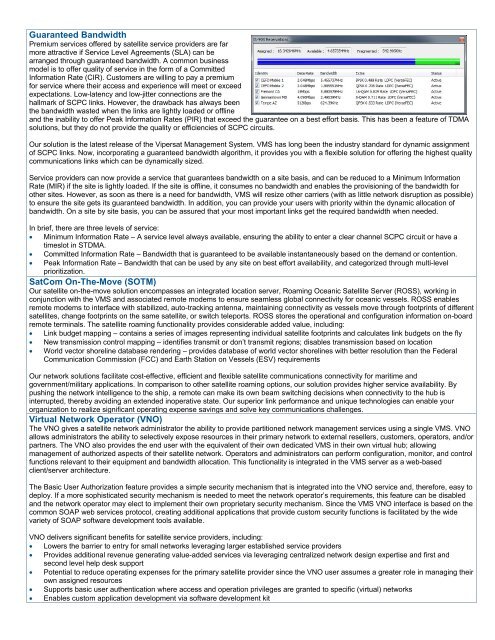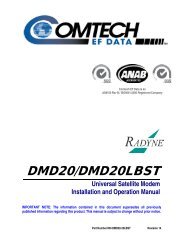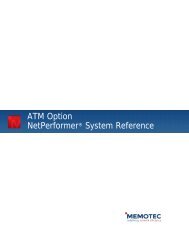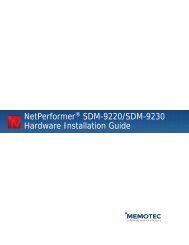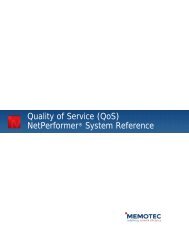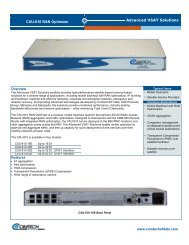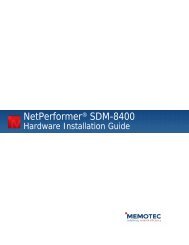VMS - Comtech EF Data
VMS - Comtech EF Data
VMS - Comtech EF Data
You also want an ePaper? Increase the reach of your titles
YUMPU automatically turns print PDFs into web optimized ePapers that Google loves.
Guaranteed Bandwidth<br />
Premium services offered by satellite service providers are far<br />
more attractive if Service Level Agreements (SLA) can be<br />
arranged through guaranteed bandwidth. A common business<br />
model is to offer quality of service in the form of a Committed<br />
Information Rate (CIR). Customers are willing to pay a premium<br />
for service where their access and experience will meet or exceed<br />
expectations. Low-latency and low-jitter connections are the<br />
hallmark of SCPC links. However, the drawback has always been<br />
the bandwidth wasted when the links are lightly loaded or offline<br />
and the inability to offer Peak Information Rates (PIR) that exceed the guarantee on a best effort basis. This has been a feature of TDMA<br />
solutions, but they do not provide the quality or efficiencies of SCPC circuits.<br />
Our solution is the latest release of the Vipersat Management System. <strong>VMS</strong> has long been the industry standard for dynamic assignment<br />
of SCPC links. Now, incorporating a guaranteed bandwidth algorithm, it provides you with a flexible solution for offering the highest quality<br />
communications links which can be dynamically sized.<br />
Service providers can now provide a service that guarantees bandwidth on a site basis, and can be reduced to a Minimum Information<br />
Rate (MIR) if the site is lightly loaded. If the site is offline, it consumes no bandwidth and enables the provisioning of the bandwidth for<br />
other sites. However, as soon as there is a need for bandwidth, <strong>VMS</strong> will resize other carriers (with as little network disruption as possible)<br />
to ensure the site gets its guaranteed bandwidth. In addition, you can provide your users with priority within the dynamic allocation of<br />
bandwidth. On a site by site basis, you can be assured that your most important links get the required bandwidth when needed.<br />
In brief, there are three levels of service:<br />
� Minimum Information Rate – A service level always available, ensuring the ability to enter a clear channel SCPC circuit or have a<br />
timeslot in STDMA.<br />
� Committed Information Rate – Bandwidth that is guaranteed to be available instantaneously based on the demand or contention.<br />
� Peak Information Rate – Bandwidth that can be used by any site on best effort availability, and categorized through multi-level<br />
prioritization.<br />
SatCom On-The-Move (SOTM)<br />
Our satellite on-the-move solution encompasses an integrated location server, Roaming Oceanic Satellite Server (ROSS), working in<br />
conjunction with the <strong>VMS</strong> and associated remote modems to ensure seamless global connectivity for oceanic vessels. ROSS enables<br />
remote modems to interface with stabilized, auto-tracking antenna, maintaining connectivity as vessels move through footprints of different<br />
satellites, change footprints on the same satellite, or switch teleports. ROSS stores the operational and configuration information on-board<br />
remote terminals. The satellite roaming functionality provides considerable added value, including:<br />
� Link budget mapping – contains a series of images representing individual satellite footprints and calculates link budgets on the fly<br />
� New transmission control mapping – identifies transmit or don’t transmit regions; disables transmission based on location<br />
� World vector shoreline database rendering – provides database of world vector shorelines with better resolution than the Federal<br />
Communication Commission (FCC) and Earth Station on Vessels (ESV) requirements<br />
Our network solutions facilitate cost-effective, efficient and flexible satellite communications connectivity for maritime and<br />
government/military applications. In comparison to other satellite roaming options, our solution provides higher service availability. By<br />
pushing the network intelligence to the ship, a remote can make its own beam switching decisions when connectivity to the hub is<br />
interrupted, thereby avoiding an extended inoperative state. Our superior link performance and unique technologies can enable your<br />
organization to realize significant operating expense savings and solve key communications challenges.<br />
Virtual Network Operator (VNO)<br />
The VNO gives a satellite network administrator the ability to provide partitioned network management services using a single <strong>VMS</strong>. VNO<br />
allows administrators the ability to selectively expose resources in their primary network to external resellers, customers, operators, and/or<br />
partners. The VNO also provides the end user with the equivalent of their own dedicated <strong>VMS</strong> in their own virtual hub; allowing<br />
management of authorized aspects of their satellite network. Operators and administrators can perform configuration, monitor, and control<br />
functions relevant to their equipment and bandwidth allocation. This functionality is integrated in the <strong>VMS</strong> server as a web-based<br />
client/server architecture.<br />
The Basic User Authorization feature provides a simple security mechanism that is integrated into the VNO service and, therefore, easy to<br />
deploy. If a more sophisticated security mechanism is needed to meet the network operator’s requirements, this feature can be disabled<br />
and the network operator may elect to implement their own proprietary security mechanism. Since the <strong>VMS</strong> VNO interface is based on the<br />
common SOAP web services protocol, creating additional applications that provide custom security functions is facilitated by the wide<br />
variety of SOAP software development tools available.<br />
VNO delivers significant benefits for satellite service providers, including:<br />
� Lowers the barrier to entry for small networks leveraging larger established service providers<br />
� Provides additional revenue generating value-added services via leveraging centralized network design expertise and first and<br />
second level help desk support<br />
� Potential to reduce operating expenses for the primary satellite provider since the VNO user assumes a greater role in managing their<br />
own assigned resources<br />
� Supports basic user authentication where access and operation privileges are granted to specific (virtual) networks<br />
� Enables custom application development via software development kit


